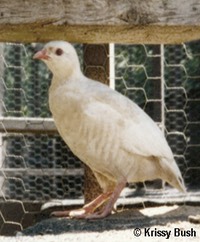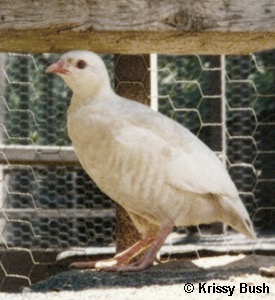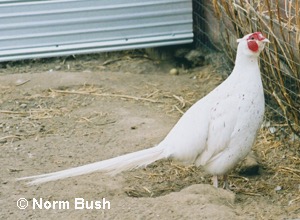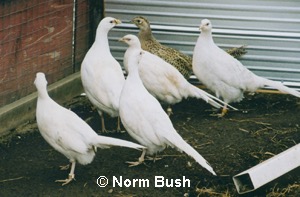• The following information comes from Gilbert, S. F. 2000. Developmental Biology Sixth Edition. Swarthmore College. Sinauer Associates, Inc. Publishers, Sunderland, Massachusetts U.S.A. Albino = a pigmentless "white" phenotype determined by a mutation in a gene coding for a pigment synthesizing enzyme. Albinism is a rare condition usually inherited in an autosomal recessive Mendelian pattern in many animals including humans. The white phenotype is the result of the body;s inability to make melanin. In humans, the albino coloration is the most obvious in the skin, hair, & retina. Albinos are generally homozygous recessive "aa" with white skin & hair and pink eye pupils (this is due to the unmasking of the red hemoglobin pigment in the blood vessels of the retina).
• The albino gene in rabbits (From Griffiths, A.J., Miller, J.H., Suzuki, D.T., Lewontin, R.C., and Gelbart, W.M. 1996. An introduction to Genetic Analysis Sixth Edition. W.H. Freeman and Company, New York U.S.A). Variants of the "C" gene in rabbits can lead to 4 genotypes: full colour (CC, Ccch, Cch,or Cc), chinchilla (cchcch, cch ch,or cchc), Himalayan (chch or chc), and albino (cc). As you can see, the "C" gene is involved in a dominance hierarchy. The Full Colour gene "C" is dominant to the Chinchilla gene "cch" which is dominant to the Himalayan (albino with black extremities) gene "ch" which is in turn dominant to the Albino gene "c".
Q: What can cause the albino phenotype? A: Mutations - mutations in an individual occur in either the somatic tissue (tissue not associated with the gonads and germ cell production) or the germinal tissue (tissue associated with the gonads and germ cell production) (From Griffiths, A.J., Miller, J.H., Suzuki, D.T., Lewontin, R.C., and Gelbart, W.M. 1996. An introduction to Genetic Analysis Sixth Edition. W.H. Freeman and Company, New York U.S.A).
• Somatic Mutations - these occur in single cells during the development of somatic tissue. Somatic cells reproduce by dividing in two so the original cell with the mutation (the mother cell) produces identical clones of itself (daughter cells) by splitting. This occurs in every reproducing cell of our body and when this process becomes accelerated by a mutation, this is called cancer. In time, a population of identical cells is produced from the original cell which occur in a localized area or a patch (this is called a mutant sector). If the mutation event occurs early in development, then the mutant sector will be larger and easier to identify than if the mutation occurred later in development. E.g. If a mutation occurred in cell of an organisms at the 4 cell stage of development, the mutation will be in 1/4 of the cells when the animal is fully developed. Compare this to a mutation that occurs at the 64 cell stage. When the animal is fully developed, the mutation will be present in only 1/64th of all of the animal's cells! If the mutation has to do with colour, the animal will appear splotchy due to different areas being different colours.
• Germinal Mutations - these occur in the germ line (tissue that will eventually form the sex cells - eggs in females and sperm in males). If a mutation occurs in a cell that becomes a gamete (a haploid sex cell) and that gamete is involved in the fertilization process (uniting of 2 different gametes), then the mutation will be passed on to the next generation (it is heritable). If the mutation is recessive, it will remain hidden, until an individual occurs with 2 copies of that mutation. If the mutation is dominant, it will be visible in the offspring/next generation.
• What types of mutations can occur? (From Griffiths, A.J., Miller, J.H., Suzuki, D.T., Lewontin, R.C., and Gelbart, W.M. 1996. An introduction to Genetic Analysis Sixth Edition. W.H. Freeman and Company, New York U.S.A).
• Loss of function mutations - this is a mutation event which destroys and deletes and/or changes critical functional regions of a gene (the gene loses its wild type function). A loss of function mutation can be either complete or incomplete. If it is complete then it is called a null mutation because there is nothing left of the wild type function. If it is incomplete, then it is called a leaky mutation because some of the wild type function "leaks" through into the phenotype. This may produce an intermediate phenotype or a gradient of phenotypes depending on the "leakiness". Loss of function mutations are generally recessive.
• Gain of function mutations - this is a mutation that causes a reception for the production of a protein to be constitutively active (it is always active). This activity is sufficient to cause an abnormal/new phenotype to develop. Gain of function mutations are dominant.
Types of Mutations known to cause albinism in various animals:
* Dominant Mutations
* Autosomal Recessive Mutations
* Sex-linked Recessive Mutations
* plus several others
• Albinism in Japanese Quail (from Crawford, R. D., 1990. Poultry Breeding and Genetics. Elsevier Amsterdam, The Netherlands.):
Types:
• Complete Albinism (autosomal recessive; completely white bodies with bright red eyes)
• Incomplete Albinism (sex-linked recessive; pink eyes with white to light yellow bodies, light barring may occur on some feathers)
• Dominant White (incomplete autosomal dominant; white bird with black skin; partially lethal; few birds survive to adulthood)
• Recessive White (autosomal recessive; white bird with a few WT feathers splashed on the head, neck, and back)
• White Feathered Down (autosomal recessive; lethal in the homozygous form; white feathers and down and black eyes)
• Brown Splashed White (autosomal recessive; white splashed with WT feathers predominantly on the head, back, wings, and breast)
• Panda (autosomal recessive; WT splashed with white; breast feathers and primaries are always white)
• White Breasted (autosomal recessive; white fronted birds-from eyes to vent)
• White Crescent (possibly autosomal recessive; white crescent on the chest of a WT colored bird)
• White Bib (possibly autosomal recessive; white bib on the chest of a WT colored bird)
• White Primaries (autosomal recessive; white primary feathers only)
Q: Why can some of these mutations be classified as albinos?
A: Albinism is the complete lack of pigment in the feathers, eyes, or skin and all of these mutations exhibit at least one of those criteria. Some have white feathers, but normal skin and eyes - they are albinos for feather colour. The mutations that exhibit a mix of feather colours are partial albinos for feather colour. Several genes (maybe more) are responsible for feather colour in birds and a mutation in at least one of these genes is leading to white feathers. These birds are an albino for the gene(s) causing the white feathers and wild type at the genes where there has been no mutation.
Albinism in Pheasants (from Crawford, R. D., 1990. Poultry Breeding and Genetics. Elsevier Amsterdam, The Netherlands.):
Types:
• Pied Spotting (autosomal recessive; pied with white feathers; dirty blue eyes)
• Blue Eyed White (autosomal recessive; completely white feathers and blue eyes; pearl white shanks and beak)
• Brown Eyed White (autosomal recessive; completely white feathers and brown eyes; buff beaks and shanks)
• Incomplete Albinism (sex-linked recessive; white bird and pink eyes; reduced viability)
• Albino (inheritance unknown; white feathers and red eyes)
• White Skin (autosomal dominant; white skin [pinky hue])
• In conclusion, albinism is not a very well studied mutation in genetics so there isn't very much information out there and the definition of an albino is disputed among geneticists. If you take the most common definition "Albino = a pigmentless "white" phenotype determined by a mutation in a gene coding for a pigment synthesizing enzyme.", you have to interpret an albino as anything where there is a mutation in a gene which results in a pigmentless phenotype. This means that any mutation leading to a pigmentless phenotype (white hair, feathers, OR skin or red eyes) should be classified as an albino. This can be extended to animals expressing these phenotypes for only part of their body (e.g. lacking pigment in their toes, have splashes of white feathers, only have red eyes). These may not be complete albinos (red eyes, white skin, & white feathers/hair), but they are partial albinos.



